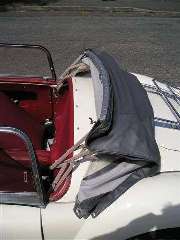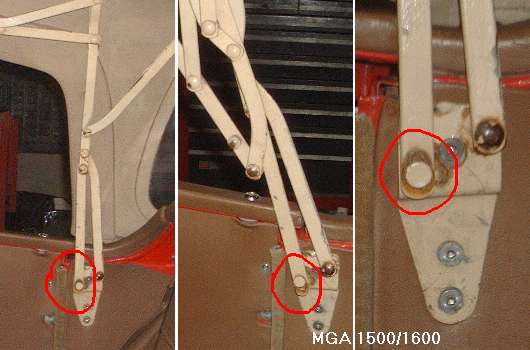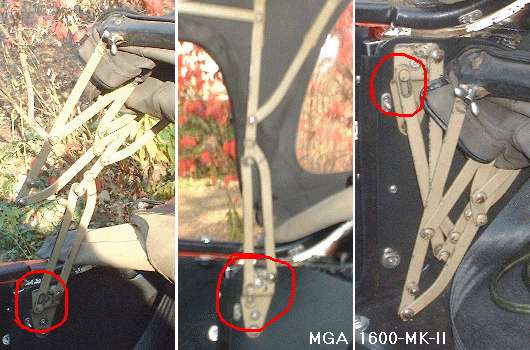The MGA With An Attitude
Difference In TOP FRAME CONSTRUCTION - TT-108B

 There are two different articulated frames for the MGA convertible tops, as noted on the prior two pages. The change point was late 1600 production at chassis number 78249. The picture here shows the late model assembly folded back over the body tonneau. The early model frame will stand straight up and lock in place, or it can collapse into the cockpit, but it cannot fold backward as shown in this picture. If you have a top frame in hand you can tell the difference by extending the leg on one side and attempting to form it to the position shown here.
There are two different articulated frames for the MGA convertible tops, as noted on the prior two pages. The change point was late 1600 production at chassis number 78249. The picture here shows the late model assembly folded back over the body tonneau. The early model frame will stand straight up and lock in place, or it can collapse into the cockpit, but it cannot fold backward as shown in this picture. If you have a top frame in hand you can tell the difference by extending the leg on one side and attempting to form it to the position shown here.
Many parts suppliers list only one part number for the MGA convertible top frame. If you need to know which one is offered you should ask before ordering, but this will most likely be the more common early type frame. If you want the later style top frame, Bob West in the UK has a fabricator-supplier for the newer type frame. There may (or may not) be other sources, but I have no further information at time of this writing.
Addendum, October 2009 - More details:
The first 500 cars had top frame AFH2629.
Other 1500's had top frame AFH2227. I have no idea what that change was, but other parts are the same.
Early 1600's had top frame AFH6670. I presume the only change was holes or notches to accommodate the center latch.
Later 1600's had top frame AFH6847. This was the one with different articulation, introduced at Car No. 78249.
See Confidential Service Memorandum MG294 (35-KB pdf file).
The wood bow in front came in three styles:
All 1500 type, thin-flat, no center latch. - AFH1746
Early 1600 type, thicker-beveled, with center latch. - AFH6671
Late 1600 and 1600-MK-II, longer at the ends. - AFH6846 - This holds the slightly wider rag top with overhanging flanges above the side curtains, and was introduced along with the change of top frame at Car No. 78249.
|
The early 1600 type bow can be used on the 1500 if you want to install the center latch (or when the early part is no longer available). The late 1600 type bow can be used for earlier (narrower) rag tops if you shorten (cut down) the ends of the wood bow to meet earlier dimensions. Using the late (long) 1600 type bow with earlier (narrow) rag tops results in the downward hanging side flaps being a little too high at front and too far out, holding the side curtains away from the windscreen posts. If you run into this situation after the top is installed, you have to burst some stitches near the front to let the hanging flap move inboard.
The parts suppliers usually don't mention that last bit, and they commonly supply only one wood bow, the latest (MK-II type) style. The wider top is commonly referred to as the MK-II top, but was introduced earlier with the change of top frame at Car No. 78249. According to the Service Parts Lists, each successive change of top frame, front bow, and canopy is supposed to supersede the prior part. When earlier parts are not available, use the later ones. If this was still true today, all earlier MGA would be changed or changing to the MK-II style rag top. Apparently car owners don't see it that way and want to keep the cars more original, so there is a good supply of rag tops in the earlier style. Unfortunately, there is not much supply of the earlier style wood bows, and vendors selling only one style wood bow would just as soon not mention it (at risk of losing a sale).
Addendum, November 2010:
Now after years of questions I can finally say how to tell the difference between early and late top frames at a glance. Notice the red circles in the pictures. (Click for larger pictures).

Pictures above are for the 1500/1600 type top frame. Pictures below are for the 1600-MK-II type top frame (after Car No. 78249). For the later top the front leg is a bit longer, and the slot at bottom of the front leg is longer, simple as that.

|


